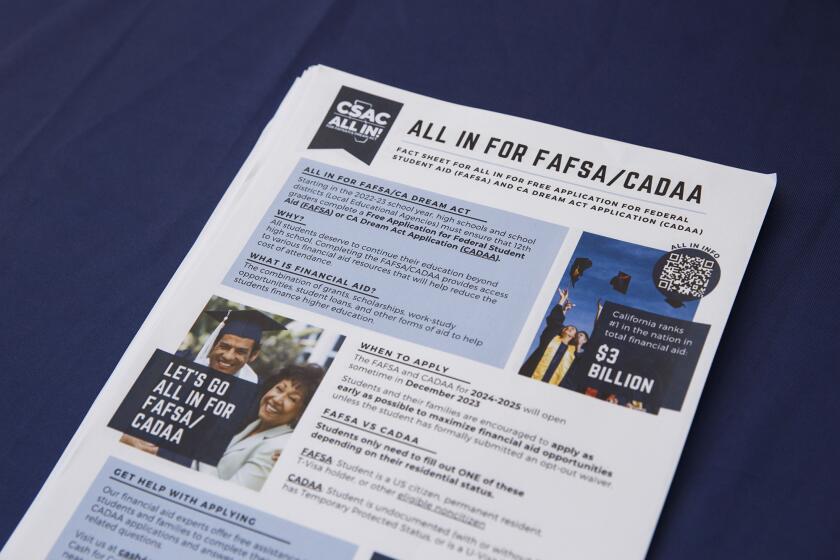DARE Effort Competing With Other Priorities
DARE Officer Michelle Bertsch rolled a suitcase crammed with anti-drug bumper stickers, pencils and T-shirts into a fifth-grade Simi Valley classroom and prepared to do what her counterparts have been doing for 17 years--teach elementary school kids to say no to drugs.
The topic of the day: pressure.
“I felt pressure when I was playing soccer,” offered one girl, her long blond hair twisted into pigtails framing a face lit with enthusiasm. “I was goalie and I let three goals go by.”
“You felt you let the team down,” Bertsch said.
“Yeah,” the girl answered.
“But you have to remember, ‘I can only do as much as I can do,’ ” responded Bertsch, gearing up to teach the students ways to handle peer pressure--a lesson she hopes will help keep them drug-free for a lifetime.
But after nearly two decades in operation, the wildly popular Drug Abuse Resistance Education program--now flourishing on 80% of all elementary school campuses in the nation--is coming under scrutiny locally as officials rethink how to use scarce police resources on campus.
This year the Ventura Police Department yanked the DARE program. Three school resource officers have been reassigned to patrol the school district’s 28 campuses, while another three are stationed full time at the city’s three high school campuses.
Ventura officials say the switch in focus is not a slap at DARE as much as a realization that keeping kids safe from drugs is not their only priority.
In light of the recent surge in school violence across the country, culminating in the April shooting deaths of 14 students and a teacher at Columbine High School in Colorado, old-fashioned law enforcement tactics have also become a top concern on local campuses, authorities said.
“When I was in school, I didn’t worry about AK-47s and somebody walking in with one and start shooting people,” said Ventura’s assistant police chief, Paul Miller. “But I had my own daughter ask me what an AK-47 is, and she’s 14. There are also these issues out there, and the kids know about it.”
The issue was brought home with even more force after a spate of bomb threats phoned into Ventura County campuses shortly after the Columbine slayings.
In a two-week span, one student was arrested on suspicion of making pipe bombs in his home, two were accused of planting phony bombs on school grounds and another was jailed after he was accused of posting a hit list of students and school administrators on the Internet.
“I liked the DARE program because it was all we had at the time,” said Joseph Spirito, superintendent for the Ventura Unified School District. “But then we saw some of the violence, kids not getting along, and we started seeing an expansion of needs beyond just drugs.”
Limited Budgets Narrow Choices
And because most departments work with limited budgets, most can’t afford both options--DARE officers on the elementary campuses and resource officers patrolling middle schools and high schools. It’s an either-or situation, officials say.
“If you’re talking about priorities--DARE or a school resource officer--I think the choice will become resource officers,” said Yolanda Benitez, superintendent of the Rio School District. “Just because the issues are so dramatic, and you have to keep children safe, that’s what’s going to happen.”
The Ventura Police Department is not the only police agency in the county to opt for the school resource officer approach over the DARE program.
Rio Mesa High School is slated for a new resource officer, funded by a state grant from the Sheriff’s Department. School officials requested the officer after a stabbing last year, Sheriff Bob Brooks said.
The Oxnard Police Department funds five school resource officers. Although the department did employ a DARE officer several years ago at one elementary school, the department preferred the school resource officer approach in the name of safety, Police Chief Art Lopez said.
“DARE officers don’t go onto a campus armed,” Lopez said. “They go on without a weapon and are not expected to provide security. They have to call other officers in order to provide enforcement activity, when it’s necessary. This provides us with more versatility than we would get with a DARE officer.”
County districts expect to receive about $2 million from the state to improve school safety. Administrators are already putting together shopping lists that include surveillance cameras, two-way radios and more cops to patrol the campuses--but not more DARE officers.
While much of the focus is enforcement, the officers are also expected to befriend students, even coming into the classrooms on occasion, at the request of a teacher.
Concerns Over a ‘Siege Mentality’
Still, DARE proponents say putting officers on campus for security purposes represents a “siege mentality.”
It’s better to provide kids with the structured, 17-week DARE program, which also covers anti-violence education and self-esteem, said Glen Levant, president of DARE American in Los Angeles. Waiting for problems to crop up at the middle school and high school campuses and then responding with arrests is a poor alternative, he said.
“If you believe in preventing crime, the character skills and respect for government and other people’s rights is established in the very early ages,” Levant said. “If you don’t have officers assist the schools working to prevent future problems, then all you are doing is reacting to situations. You can either be proactive and have officers in the elementary schools building relationships, or wait and chase the problems after they happen.”
Despite the increasing safety concerns, many departments in the county still support the DARE effort. Simi Valley, Thousand Oaks, Ojai, Santa Paula and the unincorporated areas served by the Sheriff’s Department all participate.
Local DARE supporters balk at the notion a school resource officer talking to kids between classroom periods can come anywhere close to establishing the kind of rapport a DARE officer builds in the classroom.
“I’m a little confused when other departments say a school resource officer will be taking over for a DARE officer because they do completely different functions,” Simi Valley Police Lt. Neal Rein said. “It’s apples and oranges. They do provide a certain amount of counseling and serve as a confidant role. But their primary role is to be enforcement. That’s a significant shift in philosophy.”
Officers in the classroom become friends, someone to confide in, DARE’s Levant says. But if their main job is to patrol the halls outside, he said, they remain a cop, an authority figure kids will be reluctant to approach.
And, DARE supporters add, even a cop on campus won’t prevent tragedy. At Columbine High School, an armed guard was on duty the morning two students began shooting, they note.
Difficult Decision for Schools, Police
Sheriff Brooks acknowledges the choice between DARE and a school resource officer can be a difficult one for school districts and law enforcement agencies.
But in the long run, drugs are still the biggest threat to students’ safety, Brooks said.
“It’s a much greater concern than the threat of someone coming on campus with a firearm,” Brooks said. “When you compare the statistical probability of kids being victimized by violence on campus compared to the chances of becoming involved in drugs or alcohol, there’s absolutely no comparison.”
At least one school superintendent laments having to spend money for campus police when the basic necessities are still lacking.
“The schools are not a place where we should be paying to have officers on the campus,” said Jerry Gross, superintendent of the Conejo Valley Unified School District. “Our business is education. I would rather spend those dollars first adding back counseling staff, bringing my library books up to date, art class and music classes. I have a hard time looking beyond that when our basic needs still need to be met.”
But Officer Bertsch never questions her role on campus and is happy to accept her position as cop, educator and friend. After one teaching session, a young girl in ponytails walked up to the officer and handed her a bright yellow pin that bore the word “smile.”
“I just made a friend,” Bertsch said. “I just made a connection with a young person. I think that makes it all worth my time.”
More to Read
Sign up for Essential California
The most important California stories and recommendations in your inbox every morning.
You may occasionally receive promotional content from the Los Angeles Times.










